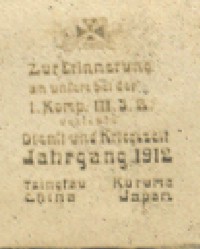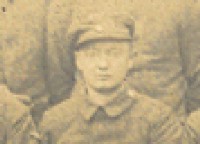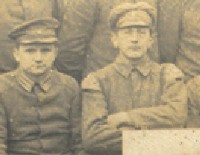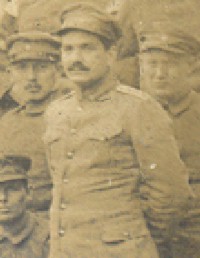|

Close up of the same photograph
showing the sign they display

Close up of the same photograph
showing NCO buttons worn on the
collar
|
This is a photograph taken
in Kurume Prisoner of War camp in Japan, showing some of the 1.
Kompanie, III. Seebataillon after their capture at Tsingtao in 1914.
Most of the soldiers wear
their 1900 Grey Litewka. Some
have the white collar patches and Litzen, some do not. Their shoulder
straps have mostly been removed.
At least one soldier has
buttons on his collar to show his NCO rank (see
NCO Rank Insignia Page). One figure
just above the sign on the left of centre clearly wears musicians
swallows nests, as does another near the top right of the group (see
Specialist Insignia Page). The
figure on the far left, mostly hidden by damage to the photograph is
wearing his Dark Blue Home
Uniform. Another figure on the far right wears an officers' khaki
tunic with two breast pockets.
Most of the soldiers wear
their khaki peaked caps, although a couple wear dark blue peakless
caps with white piping and hatbands. Both styles of cap have small
imperial cockades on the front.
Their trousers are for the
most part from their home uniforms and are dark blue with white
piping.
One of the men in this
grouping (possibly the one marked with an X lying down on the left) is
Jacob Heckenbücker (see
Seesoldat Heckenbücker
for biographical details).
|

Close up of the same photograph
showing the figure on the left
has collar Litzen. The one on the right has no Litzen but does have
musicians swallow's nests.

Close up of the same photograph
showing what is perhaps a junior
officer wearing a khaki uniform, unusually for the Seebataillon with two
breast pockets. |